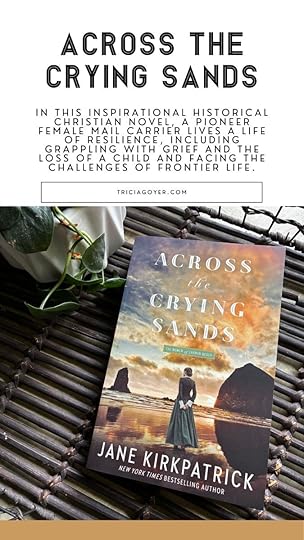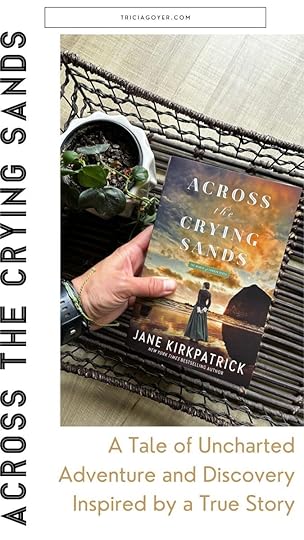Writer’s Desk with Jane Kirkpatrick
 Tricia Goyer
Tricia Goyer Writer’s Desk with Jane Kirkpatrick
Writer’s Desk with Jane KirkpatrickJane Kirkpatrick is the NY Times Bestselling and award-winning author of 41 titles, including 33 novels based on the lives of actual historical women. In 2024, she received the Lifetime Achievement Award from the Will Rogers Foundation for her contribution to Western Literature. Her works have won national awards, including the Wrangler, the Carol, and WILLA Literary Awards, and have been short-listed for the Spur, Oregon Book Award, and Christy. Several are translated into foreign languages and optioned for films. She is a founding member of Women Writing the West. Jane has keynoted conferences around the world about the power of story. A former rancher and Mental Health Director, and consultant to Indigenous communities, Jane and her husband now live part-time in Oregon and California with their Cavalier King Charles Spaniel, Rupert.
Connect with Jane on her website, Instagram, Facebook, BookBub, and Bluesky, and subscribe to her newsletter.
More about Across the Crying SandsA Tale of Uncharted Adventure and Discovery Inspired by a True Story
In 1888 Mary Edwards Gerritse is a witty and confident young woman who spends as much time as possible outdoors on the rugged Oregon coast where she and her husband, John, have settled. The two are a formidable pair who are working hard to prove their homesteading claim and build a family. But as Mary faces struggles of young motherhood and questions about her family of origin, she realizes that life is far from the adventure she imagined it would be.
After losing the baby she’s carrying, grief threatens Mary, but she finds an unconventional way to bring joy back into her life–by taking over a treacherous postal route. As Mary becomes the first female mail carrier to traverse the cliff-hugging mountain trails and remote Crying Sands Beach, with its changing tides and sudden squalls, she recaptures the spark she lost and discovers that a life without risk is no life at all.
Purchase a copy of Across the Crying Sands.
Enter to Win a Copy of Across the Crying SandsQ&A with Jane KirkpatrickARCF: What inspired you to write Across the Crying Sands? Was it based on a true story or historical figure?
JK: A faithful reader of many of my novels told me about Mary who was the first woman to deliver the mail along the rugged Oregon Coast in the 1890s. I encouraged her to write it! But she kept my interest up with tidbits, research documents, maps etc. I waited awhile (13 years) before that story called my name but I’m so glad it did!
ARCF: The title is so evocative—what does “Crying Sands” symbolize in the story?
JK: When one walks along the sand of this Oregon beach – now named Cannon Beach – there is a singular sound that indigenous people refer to as the sand crying. During a tsunami of the late 1700s, many native women were drowned while collecting food for their families and their descendants say the sands are crying. There is a resonance to beach walking where great joy can be found but it is also a place where people seek out respite, contemplate life, sever their sorrows with the message of faithfulness that the enduring tides grant. So I think crying sands is a metaphor for troubling times and how we get through them.
ARCF: How would you describe the heart of this novel to someone hearing about it for the first time?
JK: This is a story of one family’s experience with the coastal landscape, intricate relationships, the dignity of work as a parent and a postal carrier in the 1890s and the journey toward spiritual understanding in challenging times.
ARCF: What part of the story moved or surprised you the most as you wrote it?
JK: I thought it was fascinating that a woman carried the mail over a treacherous terrain, but as I researched, I learned Mary did this work while she and her husband had four children at home. In fact, they hired a nanny to look after them which intrigued me for a family to do in the 1890s. I wanted to explore what might have gone into that unusual decision for a woman/family of that era.
ARCF: What key themes—resilience, identity, forgiveness—rise to the surface in this novel?
JK: A key theme is finding one’s purpose even when other’s may question our journey. I wrote that Mary – who was a poet as we found a copy of at least one of her poems – loved an Edward Lear poem called The Jumblies. There’s a repeated stanza about “going to sea in a sieve” and the risk and inspiration such an act could give. Loss, grief, and discovering where one came from are also themes woven into this family story where sometimes to find ourselves and our purpose, one has to enter that sieve and head to sea, trusting we are not alone.
ARCF: Which secondary character added unexpected depth or emotion to the story?
JK: Jewell is an indigenous character who is a composite of the coastal tribes – Nehalem, Clatsop — who first settled the lands that Mary and her husband homesteaded. Jewell is a natural healer and dealing with her own journey and loss. Her presence for Mary and the reader I think, is calming in a story that has great turmoil.
ARCF: What kind of research did you do for this book, and did you uncover anything unexpected or particularly powerful?
JK: I visited the landscape, of course, to get a feel of the beach, the mountain, the difficulty in getting there in the 1890s and how hard Mary’s mail route would have been. Mary in later life gave many interviews which revealed her personality. I located those at little museums and history centers. Then there were the documents – photographs, deeds, census records and perhaps most intriguing, Mary’s father giving permission for her to marry John because she was only 16. The document named her as Minnie Edwards, not Mary, which piqued my interest. Other documents located will unveil more of that mystery in book two and three.
ARCF: Did you visit any of the landscapes or locations that inspired the setting of the novel?
JK: Oh, yes! That’s half the joy of writing about historical people in historical settings. I like walking where Mary and John might have walked, imagine what their views were like. Most importantly, contemplating the dangers Mary faced in a landscape where she delivered the mail.
ARCF: Was there a scene that was especially challenging—either emotionally or structurally—to write?
JK: Just two days before John and Mary married, they nearly drowned by a Pacific sleeper wave. Mary and her horse were washed onto a craggy rock surrounded by the tide. She believed John and a friend traveling with them were dead. Helping her make decisions about what next and grieving without losing hope was a section that caused much rewriting. I even asked for the manuscript back after I turned it. I had taken an on-line writing class about writing emotion authentically. My editor allowed me to keep making the scene better. I hope.
ARCF: If you could ask one question to the historical woman (or people) behind this story, what would it be?
JK: Did I get your story right? Where I had to fill in the gaps of the history, explore the why and the feelings experienced, was I authentic to what you would want readers to know?
ARCF: Have any readers shared personal stories with you after reading your work—especially those connected to this book’s themes?
JK: This book has just been released but already I have heard from readers sharing their experiences on this very beach. One said she would never drive over that coastal mountain in the same way, without thinking of Mary’s courage. Several people explored Mary’s struggle as a young wife and mother whose husband was gone at sea for three months at a time and how they struggle as a military wife over those same issues of loneliness, self-doubt, and seeking God’s purpose. One woman said she thought she was on the same journey as Mary.
ARCF: If you could write a sequel or companion novel to Across the Crying Sands, what story would it tell?
JK: Aha, I have written a second book in the series titled “With the Enduring Tides.” While book one was about one’s more personal struggle and identify, book two has themes of family, making a home, and the role of friendships for dealing with challenges. Book three is turning out to be about neighbors and strangers and building community. It’s a work in progress and not yet titled.
Save, Pin, Share

 The post Writer’s Desk with Jane Kirkpatrick appeared first on Tricia Goyer.
The post Writer’s Desk with Jane Kirkpatrick appeared first on Tricia Goyer.



